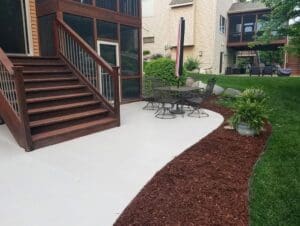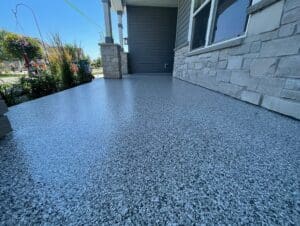Introduction: Why Polyurea Coatings are Perfect for Minnesota Flooring Solutions
When it comes to flooring solutions in Minnesota, few materials stand out like polyurea coatings. But what makes polyurea coatings so exceptional for homes and businesses in Minneapolis, Eden Prairie, Chanhassen, and Plymouth? To understand their superior performance and longevity, it’s essential to explore the science behind polyurea.
At its core, polyurea is the product of a chemical reaction between isocyanates and amines, resulting in a robust and flexible polymer. This reaction forms the foundation of polyurea’s impressive properties, including high tensile strength, chemical resistance, and mechanical durability—key features needed to withstand Minnesota’s harsh and varied weather conditions.
The unique combination of hard and soft segments within the polyurea structure, held together by strong hydrogen bonds, allows it to endure high strain rates and maintain integrity across a wide temperature range. This intricate chemistry is what sets polyurea apart, making it an ideal choice for various applications such as industrial flooring, garage floors, and outdoor spaces that face Minnesota’s seasonal extremes.
The Chemical Structure and Reaction Process of Polyurea
The Components: Isocyanates and Amines
Polyurea coatings are crafted from two primary components: isocyanates and amines. The isocyanate component, often referred to as the “A” side, is a highly reactive molecule containing the isocyanate functional group (-N=C=O).
This component is essential for forming the urea linkages that give polyurea its robust properties. Conversely, the amine component, or the “B” side, typically consists of polyetheramines or other amine-terminated resins. These amines have multiple amine groups (-NH2) that react with the isocyanates to create the polyurea polymer.
The choice of amine significantly influences the final properties of the polyurea, such as its flexibility, durability, and chemical resistance. Additionally, additives like pigments, flame retardants, and defoamers can be included to enhance specific properties of the coating. Chain extenders, often used in the amine component, promote the formation of hydrogen bonds between polymer chains, enhancing the mechanical properties of the polyurea.
The Polymerization Reaction
The formation of polyurea involves a rapid polymerization reaction between isocyanate and amine components. This step-growth polymerization sees isocyanate groups reacting with amine groups to form urea linkages (-NH-CO-NH-), occurring almost instantaneously—within seconds. This rapid curing time is why polyurea coatings are favored for their efficiency and quick turnaround.
During this reaction, the isocyanate and amine molecules combine to form carbonyl functional groups (C=O) linked to two amine groups, creating the urea linkage. This linkage is the backbone of the polyurea polymer, responsible for its high tensile strength, chemical resistance, and overall durability.
The swift nature of this reaction allows for quick application and curing, making polyurea coatings highly efficient for various industrial and protective applications. The resulting polymer structure features an alternating arrangement of hard and soft segments. The hard segments, formed by the urea linkages, provide mechanical strength and rigidity, while the soft segments, typically derived from the polyetheramine component, contribute flexibility and elasticity.
This balanced structure is key to the versatile performance of polyurea coatings, making them ideal for Minnesota’s fluctuating climate and demanding flooring needs.
Environmental Resistance of Polyurea Coatings
Chemical Resistance
Polyurea coatings are renowned for their exceptional chemical resistance, making them an ideal choice for environments where chemical spills or exposure to harsh substances are common. This resistance stems from the strong urea linkages formed during polymerization, which create a robust barrier against a wide range of chemicals, including petroleum-based and caustic substances. For Minnesota homeowners and businesses, this means reliable protection against common garage contaminants like oil, gas, and road salt.
This chemical resistance also extends to moisture, stains, and abrasions, further enhancing the longevity and performance of the coating. Whether it’s resisting stains from spills or preventing damage from salt used during Minnesota’s snowy winters, polyurea coatings ensure your floors stay pristine and durable.
Weather and Temperature Resistance
Beyond chemical resistance, polyurea coatings also offer remarkable weather and temperature resilience. They are highly resistant to water, UV radiation, and extreme temperatures, making them perfect for both outdoor and indoor applications throughout Minnesota’s diverse climate.
In Minnesota’s cold winters, polyurea coatings maintain their flexibility and do not crack under freezing temperatures, a significant advantage over other coatings like epoxy. This flexibility allows the coating to expand and contract with the substrate without losing integrity, preventing water infiltration and ensuring consistent performance even during frequent freeze-thaw cycles.
Additionally, polyurea coatings are resistant to UV radiation, helping to prevent degradation and discoloration over time. This property is essential for maintaining both the aesthetic and functional integrity of the coating, even when exposed to the intense summer sun.
The combination of these resistances makes polyurea coatings a versatile and reliable choice for a wide range of applications in Minnesota, from construction and industrial settings to automotive and marine environments.
Application Techniques and Their Impact on Longevity
Spray Application Method
The application of polyurea coatings typically involves a spray method using highly specialized, plural-component spray equipment. This equipment ensures that the isocyanate and amine components are mixed at the correct ratio, usually 1:1, and heated to the appropriate temperature before being sprayed onto the surface.
The spray gun disperses these components, which then react to form the polyurea membrane almost instantly—within seconds to minutes of application. This rapid reaction and application process allows for high-build applications, where up to 500 mils of coating can be applied in a single pass, unlike other coating materials that may require multiple layers. The spray application method also ensures a uniform and smooth coating, which is essential for achieving the desired protective and aesthetic properties of the polyurea coating.
Equipment and Mixing
Precision in mixing and equipment setup is critical for the successful application of polyurea coatings. The components are transferred into separate tanks within the spray rig apparatus and heated to ensure optimal reaction conditions. This setup guarantees that the polyurea membrane forms consistently and adheres well to the substrate, contributing to its long-lasting performance in Minnesota’s demanding environments.
Impact of Proper Surface Preparation
Proper surface preparation is vital for the longevity and performance of polyurea coatings. Before applying the coating, the surface must be thoroughly cleaned to remove any contaminants, such as dirt, oil, or old coatings. This step is essential for ensuring proper adhesion between the polyurea and the substrate, whether it is concrete, metal, wood, or another material.
Abrasive sandblasting or the application of a suitable primer may also be necessary to enhance the bond between the substrate and the polyurea coating. For example, in the case of concrete floors, it is important to test the moisture levels, ensuring they are below 8% to prevent any issues with adhesion and the overall durability of the coating. Additionally, any loose materials or debris must be vacuumed away, and the surface should be free of any obstructions or unevenness.
This meticulous preparation ensures that the polyurea coating adheres evenly and strongly, thereby maximizing its protective capabilities and extending its lifespan. By following these application techniques and ensuring proper surface preparation, Minnesota homeowners and businesses can guarantee a durable and long-lasting polyurea coating that meets their specific needs and withstands various environmental and mechanical stresses.
Conclusion: Polyurea Coatings – A Perfect Fit for Minnesota’s Flooring Needs
Whether you’re upgrading your garage, revamping a patio, or transforming a commercial floor in Minneapolis, Eden Prairie, Chanhassen, or Plymouth, polyurea coatings offer a superior solution that combines advanced science with lasting performance. As outlined, the unique chemical structure and rapid curing time of polyurea make it an ideal choice for various applications, providing high chemical resistance, weather and temperature resilience, and exceptional mechanical properties.
For those in Minnesota, Volt Coatings stands as a trusted name, bringing three generations of concrete expertise and award-winning application techniques to deliver floors that are both durable and beautiful. From impact-resistant garage floors to weather-tough patio coatings, Volt Coatings helps homeowners and businesses enhance their spaces. If you’re looking to protect and beautify your concrete surfaces, consider the benefits of polyurea coatings.
Request your free quote today from Volt Coatings and discover why so many Minnesotans choose their services for results that last.
FAQ
What are the most common applications of polyurea coatings?
The most common applications of polyurea coatings in Minnesota include:
- Concrete coatings and structural protection.
- Bridge and steel structure coatings to fight corrosion.
- Automotive industry for fascia and aftermarket parts.
- Roofing and flooring for commercial and industrial buildings due to their waterproofing qualities.
- Water and wastewater treatment plants, storage tanks, and pipelines.
- Food processing and cold storage facilities for a monolithic barrier against moisture and contaminants.
How long does it take for a polyurea coating to cure?
Polyurea coatings typically cure to the point of being touchable within a few hours and are fully cured after about 24 hours. Factors such as temperature, humidity, and the application method can influence the curing time.
Can polyurea coatings be painted, and if so, what types of paint are recommended?
Polyurea coatings can be painted, but there is a risk of the paint cracking over time. It is important to ensure the polyurea surface is properly prepared before applying any paint. While no specific types of paint are universally recommended, using high-quality, flexible paints can help mitigate cracking issues.
Why is it advisable to have a professional install polyurea coatings?
Having a professional install polyurea coatings ensures longevity, safety, and durability. Professional applications avoid common DIY mistakes, provide non-slip safety features, and use premium materials, leading to substantial long-term savings. Additionally, professionals ensure that the surface is properly prepared and that the coating is applied evenly, resulting in a surface that remains aesthetically pleasing and functional for a longer period.



